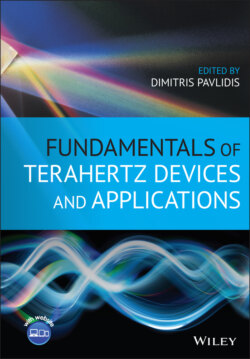Читать книгу Fundamentals of Terahertz Devices and Applications - Группа авторов - Страница 20
2.2.2.2 Spreading Factor S(Q)
ОглавлениеLet's now analyze the power balance in an elliptical lens antenna. We can evaluate the incident power crossing an area A (see Figure 2.5a) by considering each ray incident on a point Q as a plane wave. The orthogonal and parallel components of the incident power are defined as follows:
(2.32)
(2.33)
where Si represents the amplitude of the Poynting vector. The same can be done for the reflected power towards inside of the lens:
(2.34)
(2.35)
and for the transmitted power:
(2.36)
(2.37)
Figure 2.5 (a) Incident, reflected, and transmitted power density in a dielectric lens. (b) Referenced geometrical parameters.
The relation between the incident, reflected and the transmitted power density is represented in Figure 2.5a. The power transmitted by the ellipse Pa and propagating in parallel to the z‐axis through the aperture area of dAa = ρ′dρ′dϕ, is equal to the transmitted power, Pt, by the ellipse through the area ; where ri is the distances between the first focus and the lens surface (see Figure 2.5b). Moreover, the transmitted power is related to the power incident, on the lens surface, Pi (i.e. neglecting the reflected power):
(2.38)
where Pa = SadAa and Pi = SidAi; Sa and Si are the amplitude of the Poynting vectors of the aperture, and incident fields, respectively. Moreover, τ is the Fresnel coefficient in transmission, θi and θt are the incident and transmitted angles on the lens surface, respectively. By using the relations ρ′ = ri sin θ, (2.38) can be simplified as:
(2.39)
The amplitude of the aperture and incident Poynting vectors can be expressed as:
(2.40)
(2.41)
where |Ea| is the amplitude of the electric field on the equivalent aperture of the lens, and |Ei| is the amplitude of the far‐field pattern of the incident electric field. Moreover, the term can be simplified as:
(2.42)
where . The term can be calculated as:
(2.43)
by substituting (2.43) in (2.42):
(2.44)
by substituting in (2.39):
(2.45)
For an elliptical lens with , one can represent cos θi and cos θt as:
(2.46)
(2.47)
by substituting (2.46) and (2.47) in (2.45), the amplitude of the field at equivalent aperture of the lens is related to the amplitude of the incident field as:
(2.48)
Therefore, the spreading factor can be defined as:
(2.49)
This is because, in the considered geometry (feed at the focus), the output GO phase front is planar and consequently has no power spreading.
